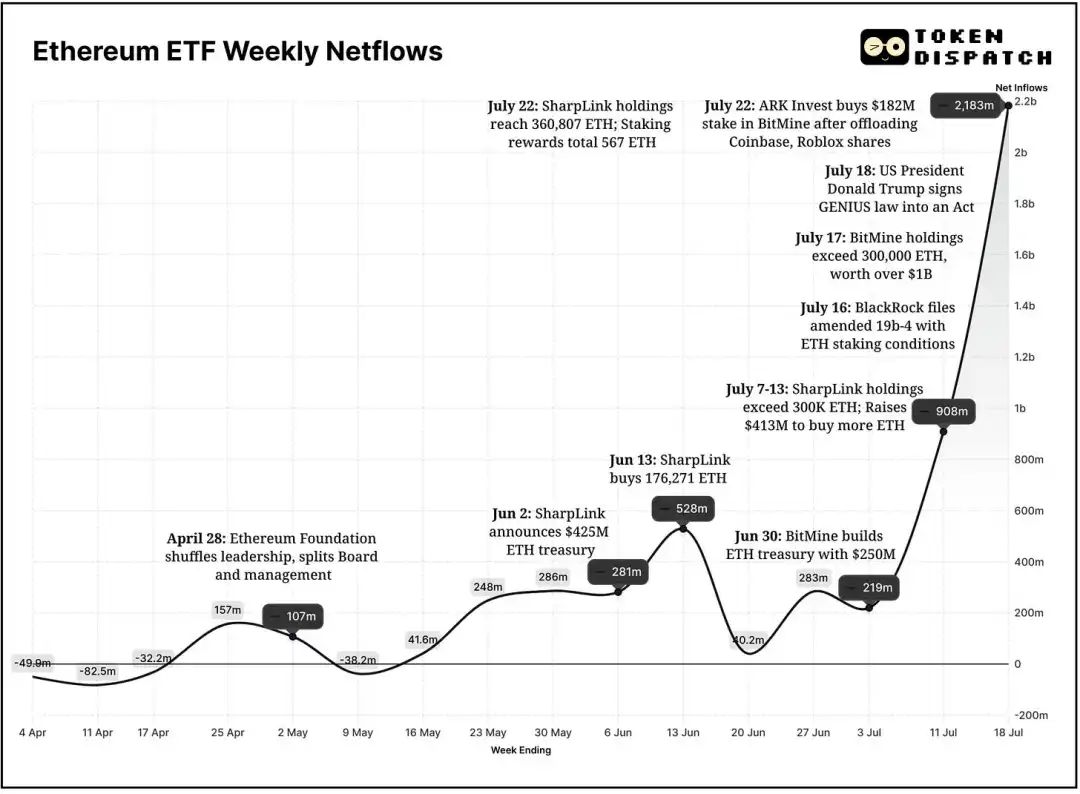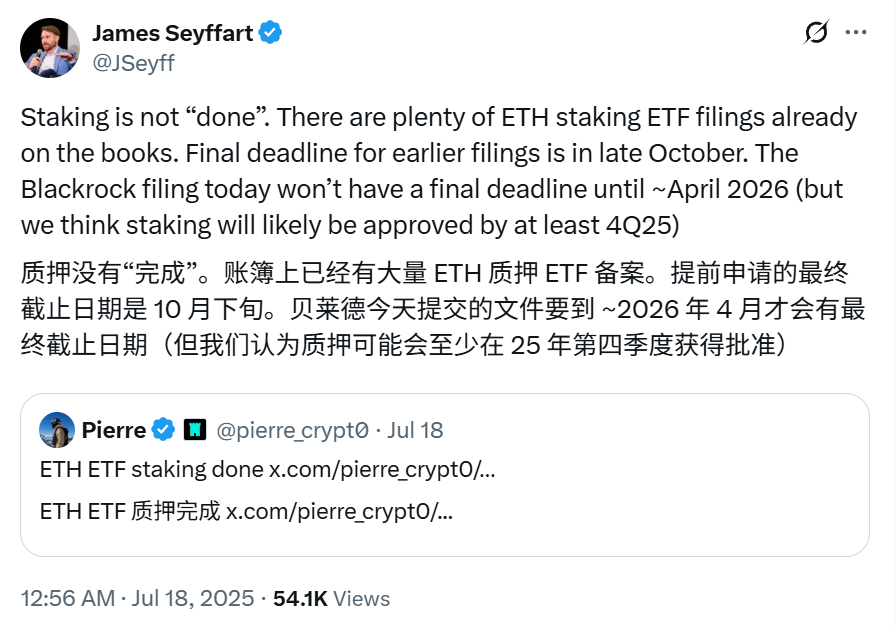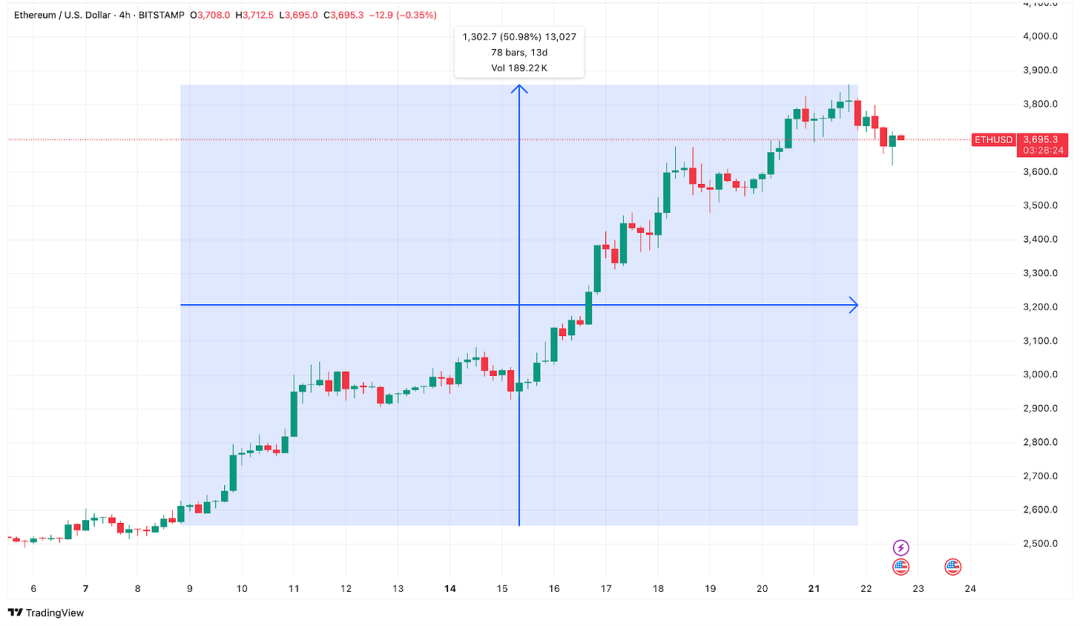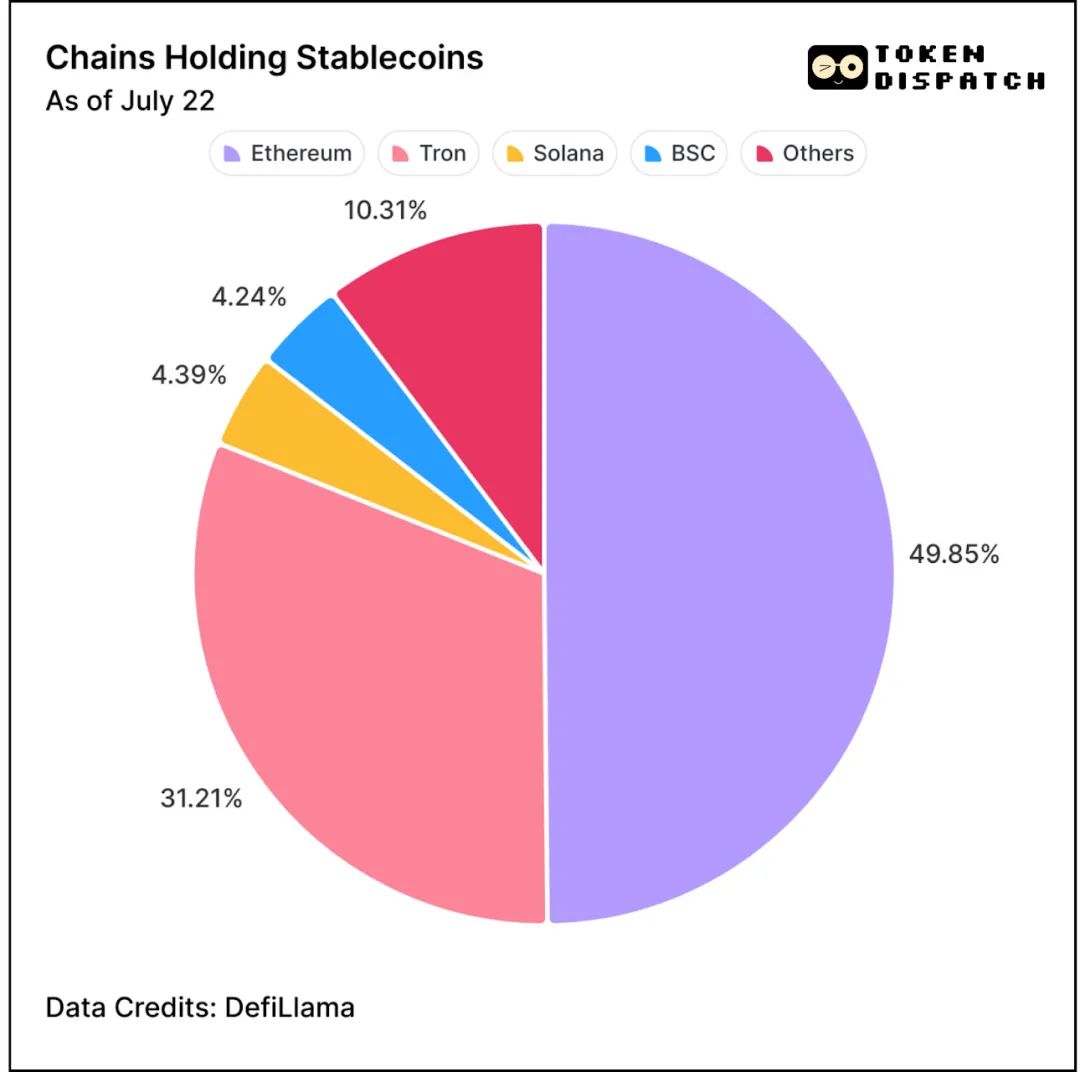Author: thetokendispatch
Translation: Blockchain in Plain Language
Three months ago, even the most ardent supporters of Ethereum could hardly imagine that Ethereum would be celebrating the one-year anniversary of its ETF launch in the United States. However, on July 23, 2025, the Ethereum ETF marked its first anniversary since it began trading on July 23, 2024, and is currently in the spotlight.
In June 2025, the Ethereum ETF recorded its best single-month performance ever, with net inflows exceeding $3.5 billion, a 70% increase over the previous record set in December 2024. Data for July has already shown a trend surpassing June, with over $3 billion in net inflows recorded to date. The past two weeks (as of July 18) have become the highest net inflow weeks in history, with ten consecutive weeks without any net outflows, marking a first in its 52-week history.
The hockey stick growth pattern in the chart below clearly illustrates this story.

Ethereum ETF Weekly Net Inflows
01 Early Setbacks: From Indifference to Comeback
The situation has not always been so smooth.
In May 2024, U.S. regulators approved the Ethereum ETF, and trading began on July 23, but the market response was tepid. The Bitcoin ETF had already stolen the spotlight earlier that year, making the debut of the Ethereum ETF seem largely ignored. Price fluctuations were minimal, and interest gradually waned, with the early months failing to attract significant capital inflows. In fact, there were even net outflows during the initial phase.
In the first 39 weeks post-launch, the Ethereum ETF recorded positive net inflows in only 15 weeks. However, in the most recent 14 weeks, 13 weeks showed net inflows, indicating a significant shift in market sentiment over the past three months. As of July 21, 2025, the total assets under management of the U.S. Ethereum ETF surpassed $19 billion, doubling from about $9.6 billion two months ago.
02 Institutional Surge: The Rise of the Ethereum Treasury
The ETF is not the only product gaining traction for Ethereum; institutional interest in Ethereum is also accelerating through the Ethereum Treasury.
On June 2, SharpLink Gaming became the first U.S. publicly traded company to announce the inclusion of Ethereum in its treasury strategy. While many companies were racing to add Bitcoin to their balance sheets, Ethereum co-founder and ConsenSys founder and CEO Joe Lubin joined the board of SharpLink Gaming as chairman and led a $425 million Ethereum treasury strategy. Since the launch of this plan, SharpLink has become the largest corporate holder of Ethereum, holding 360,807 ETH and earning a cumulative reward of 567 ETH through staking. Additionally, the company is seeking to increase its available common stock from $1 billion to $5 billion in its supplemental prospectus with the SEC.
Meanwhile, Bitcoin miner BitMine Immersion is also making a significant bet on Ethereum, holding over 300,000 ETH (worth over $1 billion). Its chairman, Wall Street veteran Tom Lee, stated: "Our goal is to acquire and stake 5% of the total Ethereum supply." The Ethereum holdings of SharpLink and BitMine have now surpassed those of the Ethereum Foundation.
Furthermore, Cathie Wood's ARK Invest recently sold a significant portion of its holdings in Coinbase and Roblox, investing $182 million to increase its stake in BitMine Immersion, adjusting the allocation of BitMine in its three flagship ETFs to 1.5%. Billionaire Peter Thiel also holds a 9.1% stake in BitMine. The newly established Ether Machine company plans to create a publicly traded entity that provides institutional-grade Ethereum infrastructure and yield exposure through the merger of existing companies, aiming to list on Nasdaq and holding over 400,000 ETH.
03 Turning Point and Future: Staking and Institutional Prospects
What has changed in the past few months? Leadership adjustments at the Ethereum Foundation may have played a role. In late April, the Ethereum Foundation underwent a leadership restructuring, separating the board from management, with the new leadership clearly defining three priorities: expanding the Ethereum base layer, improving Layer 2 rollups, and enhancing user experience.
The utility and yield-generating capability of Ethereum make it highly attractive to investors. Currently, U.S. ETFs do not offer staking rewards, as the U.S. Securities and Exchange Commission has not yet approved them. If the Ethereum ETF is eventually allowed to offer staking services, Ethereum could become a "digital bond" in institutional portfolios. An ETF that supports staking could provide 3-5% native yield, which, based on the current $19 billion in holdings, could generate over $750 million in staking income for ETF issuers at an average yield of 4%.
BlackRock has begun exploring structures that include staking, submitting a revised 19b-4 filing that explicitly mentions staking as a "potential future feature," pending regulatory approval. Experts predict that ETF staking may be approved in the last quarter of this year. Market-making and trading firm Wintermute noted last year that the lack of a staking mechanism diminished Ethereum's appeal as an ETF tool. If the macro environment changes, Ethereum's scarcity, staking yields, and the accessibility of ETFs and custodians will make it a highly attractive option.

The price of Ethereum has risen in tandem with institutional activity, surging over 50% in the past two weeks, reaching a new high for 2025, and accumulating a 150% increase over the past three months. When new shares of the ETF are issued, Ethereum must be purchased, which will lock up supply, reduce the available Ethereum in the market, and drive up prices. Treasury builders are positioning Ethereum as programmable collateral—an asset that can generate yield, provide security, and be held long-term.

Recent Price Trends of Ethereum
Additionally, the macro environment is favorable: The GENIUS Act has been signed into law, legalizing stablecoins as digital cash. As the dominant blockchain network with a 50% market share, Ethereum will be the biggest beneficiary.

Share of Stablecoins Across Public Chains
04 Conclusion
Once ETF staking is approved by the SEC, institutional interest is expected to remain high. More companies may establish Ethereum treasuries due to the staking feature, and asset management firms like BlackRock will continue to increase their Ethereum allocations. For traditional investors, Ethereum's influence through both ETFs and treasuries in locking up supply and expanding into the traditional economy will become increasingly evident.
Compared to Bitcoin's treasuries and ETFs, Ethereum's uniqueness lies in the fact that: Bitcoin is viewed as "digital gold" for value storage and macro hedging, while Ethereum serves as infrastructure for actual work. Fund issuers and treasury builders support Ethereum because it supports staking yields, infrastructure tracks, and financial utility's programmable layer. Bitcoin is the asset you hold; Ethereum is the network you build.
免责声明:本文章仅代表作者个人观点,不代表本平台的立场和观点。本文章仅供信息分享,不构成对任何人的任何投资建议。用户与作者之间的任何争议,与本平台无关。如网页中刊载的文章或图片涉及侵权,请提供相关的权利证明和身份证明发送邮件到support@aicoin.com,本平台相关工作人员将会进行核查。




